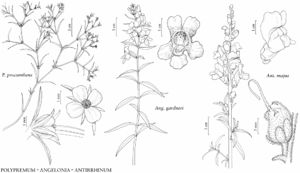Polypremum procumbens
Sp. Pl. 1: 111. 1753.
Stems (5–)8–20(–33) cm, much-branched distally. Leaves sometimes forming dense, overwintering rosettes; blade 1-veined, linear to narrowly lanceolate, (5–)10–25(–42) x (0.5–)1(–2) mm, margins ciliate proximally, apex acuminate. Bracteoles leaflike. Calyx lobes keeled, (2–)3 mm, margins scarious, especially medially, apex attenuate. Corollas 1–2 mm, usually 1/2–3/4 length of calyx lobes, lobe apex rounded. Stamens included. Capsules 2-lobed, 2 x 1.5–2 mm, slightly flattened. Seeds 0.3 mm, shiny. 2n = 20 (Guyana), 22.
Phenology: Flowering May–Nov.
Habitat: Pine woods and barrens, roadsides, sand dunes, sandy fields, waste places.
Elevation: 0–1000 m.
Distribution
Ala., Ark., Del., Fla., Ga., Ill., Ky., La., Md., Miss., Mo., N.C., Okla., S.C., Tenn., Tex., Va., Mexico, West Indies, Central America, South America, introduced in Pacific Islands, Australia.
Discussion
Collections of Polypremum procumbens were gathered from ship ballast piles in New Jersey (in 1865, 1875) and Pennsylvania (in 1865, 1868), and there was an 1873 report from Long Island, New York.
Since a report from Hawaii (F. R. Fosberg 1962), populations of Polypremum procumbens have been discovered in widely scattered locations, often near roads or runways, in the Pacific Basin. Specimens have been examined from the Territory of Guam, Kwajalein Atoll of the Republic of Marshall Islands, the Republic of Palau, Wallis Island, and one site in eastern Australia.
Selected References
None.
